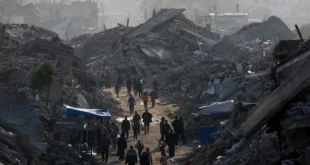- In recent days, Hezbollah has showcased its ability to counter Israeli incursions into Lebanon, launching hundreds of missiles into Israel and engaging Israeli forces in fierce ground combat operations.
- The regional dynamics have undergone a profound shift since the assassination of Nasrallah, which marked a turning point in disrupting Israel’s previous strategic dominance.
- The current situation is highly volatile, with the region teetering on the edge of a full-scale conflict and the Biden administration striving to avert broader hostilities before the upcoming U.S. presidential election, now just weeks away, recognizing that such a conflict would carry substantial global implications.
- With the further expansion of Israel’s military campaign in Lebanon, there is the real possibility of IDF mission creep, a development that could see forces occupying parts of southern Lebanon, ceding the advantage to Hezbollah, as it wages a protracted guerilla warfare campaign.
An early-morning strike on Friday reportedly targeted Hashem Safieddine, the apparent successor to Hassan Nasrallah as Hezbollah’s Secretary-General. The recent strike was allegedly more intense than the one that targeted Nasrallah a week earlier. If Safieddine’s elimination is confirmed, it would suggest that Israel has indeed managed to infiltrate Hezbollah at its highest levels, with the potential vulnerability lying within Iran, Lebanon, or both. In the unprecedented Iranian attack on Israel in retaliation for the assassination of Hamas political bureau head Ismail Haniyeh and Lebanese Hezbollah’s Secretary-General Hassan Nasrallah on Tuesday, Hezbollah has showcased its ability to counter Israeli incursions into Lebanon, launching hundreds of missiles into Israel and engaging Israeli forces in fierce ground combat operations. Eight Israel Defense Forces (IDF) soldiers were killed in fighting on Wednesday, yet despite these casualties, the Israeli invasion could be expanding, with the IDF now deploying five divisions to the border with Lebanon. The IDF issued evacuation warnings to 20 towns and villages in Lebanon as clashes continued between its troops and Hezbollah fighters along the Lebanese-Israeli border. Meanwhile, Israeli airstrikes in central Beirut on Thursday resulted in nine fatalities in the Bachoura neighborhood.
Separate from the Lebanese theater, Hamas has released footage allegedly showing attacks on Israeli troops and targets in Khan Yunis, while another Iranian proxy, the Yemen-based Houthis, sent an email to an executive at a Greek shipping company warning that the company’s ships risk being attacked for violating a Houthi-imposed transit ban against docking at Israeli ports. The email was one of several warnings sent to Greek shipping companies since May amidst rising geopolitical tensions in the Middle East. The warnings indicate the group is casting a wider net than previously by targeting ships with little or no connection to Israel, increasing the risks to commercial shipping in the Red Sea. Houthi military spokesperson Brig. Gen. Yahya Saree also claimed responsibility for attacking a Panama-flagged oil tanker ‘Cordelia Moon’ and the Liberian-flagged bulk carrier ‘Minoan Courage.’ Additionally, Iraq-based Kataib Hezbollah, another proxy that forms part of Iran’s “Axis of Resistance,” warned that an “energy war” could have severe consequences globally, potentially disrupting the supply of 12 million barrels of oil per day — an implicit response to the threat of Israeli strikes on Iranian energy infrastructure. Israel also launched strikes in the Syrian capital of Damascus, further proof that Israel’s region-wide military campaign shows no signs of letting up any time soon.
The latest development came after U.S. President Joe Biden indicated that his administration is considering the possibility of Israeli airstrikes on Iranian oil facilities, causing oil prices to increase by 4 percent, as concerns grow that escalating tensions could significantly reduce oil exports from countries in the region, including Saudi Arabia and the United Arab Emirates. President Biden suggested that he was opposed to Israel striking Iran’s nuclear facilities, a tactic Israel has used in the past against Iraq (Osirak in 1981) and Syria (al-Kibar in 2007). Without U.S. logistical support, it would be challenging for Israel to successfully attack Iran’s nuclear infrastructure, particularly the hard and deeply buried targets. Tehran, meanwhile, has conveyed a message to the United States through Qatar, stating that the “phase of unilateral self-restraint has ended,” warning that any Israeli attack will be met with an “unconventional response” targeting Israeli infrastructure.
The regional dynamics have undergone a profound shift since the assassination of Nasrallah, which marked a turning point in disrupting Israel’s previous strategic dominance. Israel dubbed the Nasrallah assassination Operation New Order, demonstrating Israel’s view that removing the Hezbollah leader could be a ‘game changer’ for regional geopolitics. Before this event, Israel, with backing from the U.S. and France, was expected to pursue a ceasefire proposal during Prime Minister Benjamin Netanyahu’s recent visit to the United States for United Nations General Assembly (UNGA) meetings. However, Netanyahu instead authorized Nasrallah’s assassination, fundamentally altering the geopolitical landscape and changing the restraint calculus of the Iranian regime. If the U.S.-French deal had been approved earlier, Israel might have retained its strategic advantage. Now, however, escalating tensions have altered the situation on the ground, especially along Israel’s northern front, where Hezbollah appears to be regaining its balance and showing signs of operational strength and capabilities.
The current situation is highly volatile, with the region teetering on the edge of a full-scale conflict. The Biden administration is striving to avert broader hostilities before the upcoming U.S. presidential election, now just weeks away, recognizing that such a conflict would carry substantial political, military, strategic, and economic implications — not only for the region but globally. President Biden announced that the Group of 7 nations (G7) — Canada, France, Germany, Italy, Japan, the United Kingdom, and the United States — agreed to impose new sanctions on Iran following the missile attack earlier this week.
Even before the IDF’s ground incursion into Lebanon, it was revealed that over the course of the past year, Israeli special operations forces have conducted dozens of raids across the Lebanese border, claiming to have attacked nearly 1,000 Hezbollah sites where they collected intelligence and sought to dismantle the militant group’s infrastructure and weapons depots. Israel claimed that this was necessary to prevent Hezbollah from conducting an operation similar to what Hamas engineered on October 7.
Another objective, now part of Israel’s official war aims, is to push Hezbollah forces back far enough so that a buffer zone is created, allowing Israeli residents to return to their homes in the north of the country. With the IDF moving more troops up to Israel’s northern border with Lebanon, the shift is likely to embolden Hamas, potentially expanding the conflict beyond Rafah into a broader military engagement across multiple fronts, including the possibility of terrorist attacks in the West Bank and Israel. Hamas’s Qassam Brigades claimed responsibility for a terror attack in Jaffa that killed seven on Tuesday evening.
With the further expansion of Israel’s military campaign in Lebanon, there is the real possibility of IDF mission creep, a development that could see forces occupying parts of southern Lebanon. Such a scenario could cede the advantage to Hezbollah, as it wages a protracted guerrilla warfare campaign, relying on a range of asymmetric tactics to blunt Israel’s military power. This includes anti-tank guided missiles (ATGMs), improvised explosive devices (IEDs), and a range of other traditional insurgent tactics such as ambushes, hit-and-run attacks, and deploying snipers in challenging terrain.
Beyond a protracted campaign, such a scenario will likely lead to increased displacement and further deterioration of the humanitarian conditions in Lebanon. An estimated 1.2 million people have been displaced throughout the country, according to the Lebanese government, and UN officials have stated that the pace of displacement since late September has exceeded “worst case scenarios.” As the conflict continues to escalate, and if prognostications of a wider regional war come to fruition, the impact on the civilian population and infrastructure will be devastating and potentially catastrophic.
 Eurasia Press & News
Eurasia Press & News




